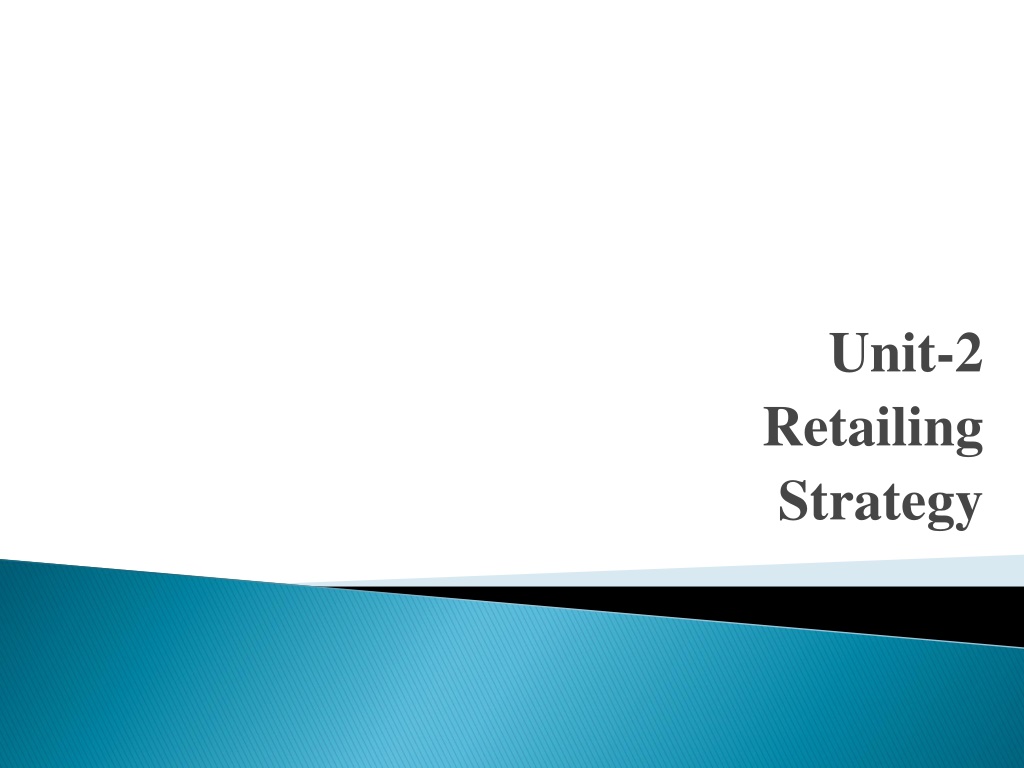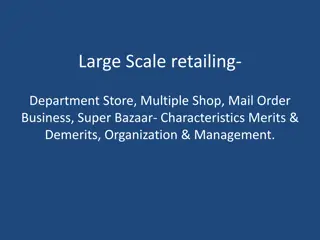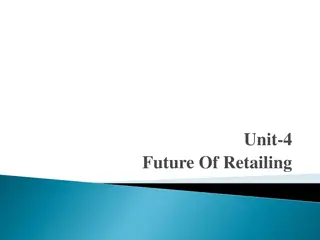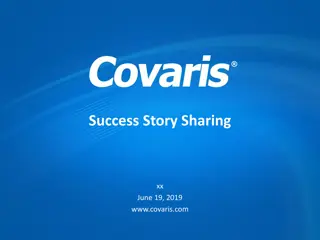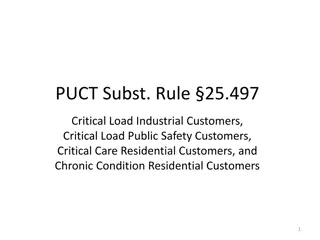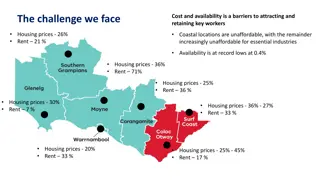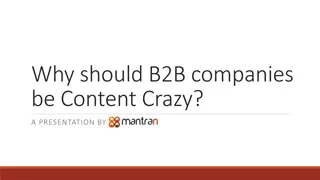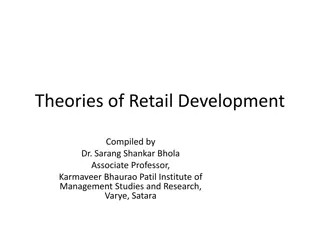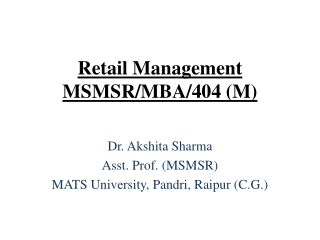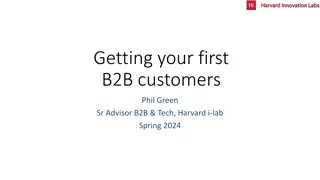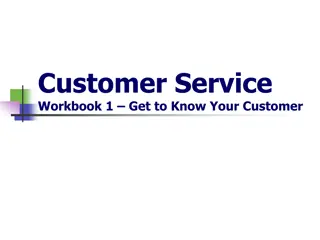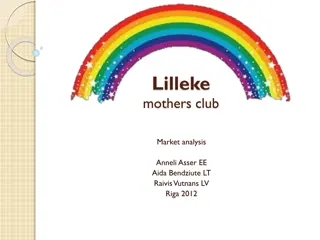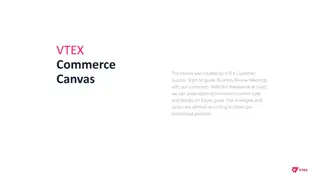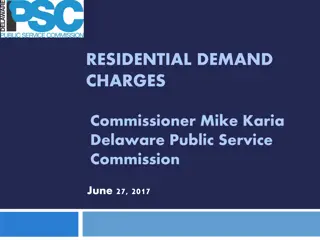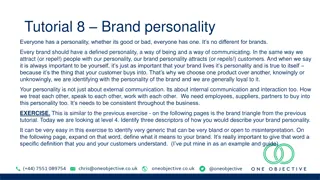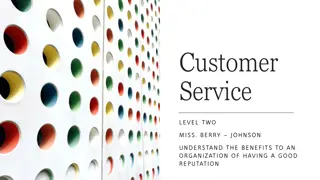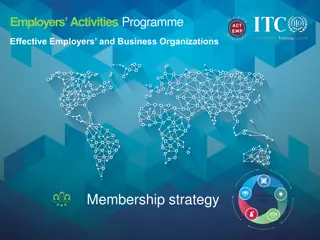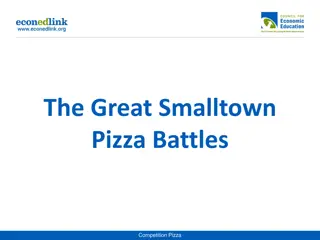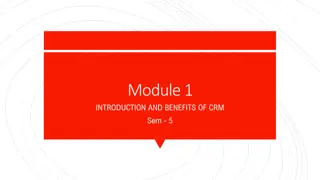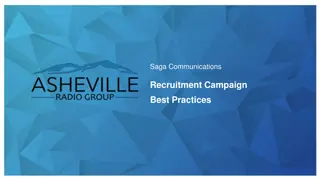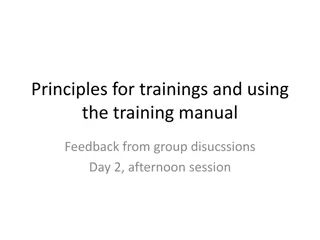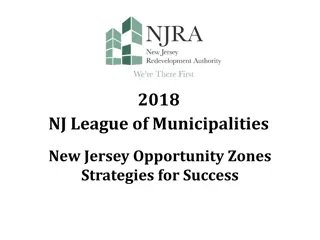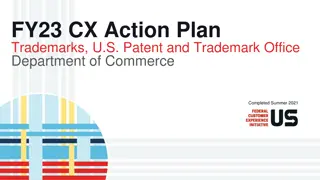Effective Retailing Strategies for Understanding and Attracting Customers
Retail strategy involves various elements such as customer segmentation, target market selection, market positioning, retail image establishment, and consumer behavior understanding. Identifying different customer segments based on characteristics like demographics or behavior helps in tailoring marketing efforts effectively for better results in the retail sector.
Download Presentation

Please find below an Image/Link to download the presentation.
The content on the website is provided AS IS for your information and personal use only. It may not be sold, licensed, or shared on other websites without obtaining consent from the author. Download presentation by click this link. If you encounter any issues during the download, it is possible that the publisher has removed the file from their server.
E N D
Presentation Transcript
Unit-2 Retailing Strategy
Contents:- Identifying and Understanding Customers Customer segmentation Selecting Target Market Identifying Market Segments selecting site locations Strategic positioning and execution. Establishing and Maintaining Retail Image Creating In-store Dynamics (Layouts & Plans)
A retail strategy is the process you use to develop your products or services and sell them to customers. There are multiple elements to this plan, including location, store, merchandise/assortment, visual merchandising, staff, service, mass media and communications, and price
Understanding retail consumer deals with understanding their buying behaviour in retail stores. Understanding the consumer is important to know who buys what, when, and how. It is also important to know how to evaluate consumer s response to sales promotion. It is very vital to understand the consumer in the retail sector for the survival and prosperity of the business.
It is sometimes difficult to understand who is actually a decision maker while purchasing when a customer enters the shop accompanying someone else. Thus everyone who enters the shop is considered as a customer. Still, it is necessary to identify composition and origin of the customers. Composition of Customers It includes customers of various gender, age, economic and educational status, religion, nationality, and occupation. Origin of Customer From where the customer comes to shop, how much the customer travels to reach the shop, and which type of area the customer lives in. Objective of Customer Shopping or Buying? Shopping is visiting the shops with the intention of looking for new products and may or may not necessarily include buying. Buying means actually purchasing a product. What does the customer s body language depict?
Customer segmentation is the process of dividing customers into groups based on common characteristics so companies can market to each group effectively and appropriately. In business-to-business marketing, a company might segment customers according to a wide range of factors, including: Industry Number of employees Products previously purchased from the company Location In business-to-consumer marketing, companies often segment customers according to demographics that include: Age Gender Marital status Location (urban, suburban, rural) Life stage (single, married, divorced, empty-nester, retired, etc.)
Segmentation allows marketers to better tailor their marketing efforts to various audience subsets. Those efforts can relate to both communications and product development. Specifically, segmentation helps a company: Create and communicate targeted marketing messages that will resonate with specific groups of customers, but not with others (who will receive messages tailored to their needs and interests, instead). Select the best communication channel for the segment, which might be email, social media posts, radio advertising, or another approach, depending on the segment. Identify ways to improve products or new product or service opportunities. Establish better customer relationships. Test pricing options. Focus on the most profitable customers. Improve customer service. Upsell and cross-sell other products and services.
After you segment buyers and develop a measure of consumer insight about them, you can begin to see those that have more potential. Now you are hunting with a rifle instead of a shotgun. The question is, do you want to spend all day hunting squirrels or ten-point bucks? An attractive market has the following characteristics: It is sizeable (large) enough to be profitable given your operating cost. Only a tiny fraction of the consumers in China can afford to buy cars. However, because the country s population is so large (nearly 1.5 billion people), more cars are sold in China than in Europe (and in the United States, depending on the month). Three billion people in the world own cell phones. But that still leaves three billion who don t (Corbett, 2008). It is growing. The middle class of India is growing rapidly, making it a very attractive market for consumer products companies. People under thirty make up the majority of the Indian population, fueling the demand for Bollywood (Indian-made) films.
It is not already swamped by competitors, or you have found a way to stand out in a crowd. IBM used to make PCs. However, after the marketplace became crowded with competitors, IBM sold the product line to a Chinese company called Lenovo. Either it is accessible or you can find a way to reach it.Accessibility, or the lack of it, could include geographic accessibility, political and legal barriers, technological barriers, or social barriers. For example, to overcome geographic barriers, the consumer products company Unilever hires women in third-world countries to distribute the company s products to rural consumers who lack access to stores.
The company has the resources to compete in it. You might have a great idea to compete in the wind-power market. However, it is a business that is capital intensive. What this means is that you will either need a lot of money or must be able to raise it. You might also have to compete with the likes of T. Boone Pickens, an oil tycoon who is attempting to develop and profit from the wind-power market. Does your organization have the resources to do this? It fits in with your firm s mission and objectives. Consider Terra Cycle, which has made its mark by selling organic products in recycled packages. Fertilizer made from worm excrement and sold in discarded plastic beverage bottles is just one of its products. It wouldn t be a good idea for Terra Cycle to open up a polluting, coal-fired power plant, no matter how profitable the market for the service might be.
Market for product is big and diverse making it difficult for companies to be able to satisfy every customer. Companies need to identify a certain set of customer within a market and work towards satisfying them. This set of identification is market segment. Companies further need to understand the intricacy of how this segment behaves and operates. An approach known as target marketing is gaining prominence where companies identify the market segment on similar needs and wants, select one of the market segments and then focus in developing products and marketing program.
In segment marketing companies identify consumer with similar needs and wants. For example, an airline is looking forward to providing no frills connectivity between metro cities on US east coast compare. This segment is within airline industry but needs of customer is different. T target audience is low budget travelers. However, customers within the segment look for different attributes, for example, lunch or beverages as part of travel. Here companies can offer this by charging the customer. In niche marketing, companies target limited customer set. A niche market is worth exploring where customers are willing to pay a premium for product, entry barriers are high and market has growth potential. In local marketing, customers are local neighborhood, trading stores, etc. For example, many banks prefer local marketing for better understanding of client and provide them right type of service. In individual marketing, companies look forward to satisfying needs and wants of individual customer. Internet is facilitating the process of individual marketing, where in customer log on to the site and creates products from available options. This process is not feasible for high technology products like automobiles.
Market planning and site selection is not based solely on where your target audience lives anymore. As consumers' schedules get more complicated and competition increases, researching your next ideal location and market has become much more complicated. There are many factors that can go into identifying, evaluating and acquiring new locations. When selecting the perfect market and site, always keep the following 4 areas in mind:
1. Accessibility Any location you consider should be easy to access. Look for places that are nearby one or more major roads (in good condition) and are easily served by public transportation, if applicable. If it makes sense for your brand, also research storefronts that are within walking distance of neighborhoods or high-rise apartments. (Note: if you are currently in a location with a lot of pedestrian traffic, make sure you have an amazing window display to draw those potential customers inside!) Besides being easy to access, consider how accessible other places are from you. Consider a location that is near other stores as well as places that people visit regularly, such as a grocery store, bank or post office. Also consider a place that is easily visible from the road. Having your sign visible to traffic is constant advertisement for your brand.
2. Competitors Check for compatibility with nearby stores when researching a site. The ideal location will have neighboring stores with a similar target audience that sell products or services that complement what you offer. For example, as a high-end boutique shop, a great location for you might be next to a nail salon and a bistro. If you are a record shop, consider finding a location near a music venue or vintage store. With this strategy, you are helping create a bigger retail experience than you could offer alone. Similarly, avoid setting up shop near direct competition, especially if they are a more established brand. If you do end up by a competitor, you will have to not only share the market, but will also need to come up with a competitive advantage to draw customers to you versus the other.
3. Parking Except for cities like New York and Chicago, parking availability is very important for your business. How many times have you decided to skip a store because you could not find a parking spot? A good measure for retailers to follow is the ratio of 3:1, or 3 square feet of parking space for 1 square foot of store. Not only should parking be readily available, but also consider the layout of the parking lot or garage. If it is easy to find a parking spot, but then difficult to get into it because the spaces or lanes are too narrow, this can also deter shoppers from returning in the future.
4. Costs Beyond the base rent, consider other costs that may affect your bottom line. If you are in a retail strip, how much will it cost you to contribute to lawn care, utilities and security? If the location is remote, how much more money will you need to spend on marketing? Is the location ready for move-in, or will it require significant repairs? What are your common area maintenance (CAM) expenses? These costs can quickly add up and make a seemingly cheap option into a money pit.
Objective 1 To show the importance of communicating with customers and examine the concept of retail image. 2 To describe how a retail store image is related to the atmosphere it creates via its exterior, general interior, layout, and displays, and to look at the special case of non-store atmospherics. 3.To discuss ways of encouraging customers to spend more time shopping. 4.To consider the impact of community relations on the retailer s image
Introduction A retailer needs a superior communication strategy to properly position itself in customers minds, as well as to nurture their shopping behaviour. Once customers are attracted, it is then imperative for the retailer to create a proper shopping mood for them. For most service oriented retail business, various physical evidence and symbolic cues are used to create the so call shopping mood, this is essential as to maximize the total retail experience.
The significance of retail image Image refers to how retailer is perceived by customers and others. While, positioning refers to a firm s devising its strategy so as to project an image relative to its retail categories and its competitors and to elicit a positive image. To succeed, a firm must communicate a distinctive, clear, and consistent image once image is established in consumers minds, a retailer is placed in a niche relative of competitors.
Components of a retail image There are several factors that contribute to a retailer s image, and it is totality of them that forms an overall image. These factors are: Target market Firm s positioning Customer service Store location Merchandise attributes Pricing
Store Design objective Implement the retailers strategy Influence the customer buying behavior Provide flexibility control design and maintenance costs meet legal requirements
Store Design and Retail strategy Primary objective: to implement retailers strategy Design- consistent and reinforce the retailers strategy by meeting the needs of the target market and building a competitive advantage. Eg Sam`s-price sensitive- floor design and racks metal and concrete to reinforce the brand image Flooring and shelving also affect retailers image: glass-elegance
Influence customer buying behaviour Store design- should attract customers, enable them to locate merchandise, keep them in the store for as long time, motivate them to make unplanned, impulse purchase and provide them with a satisfied customer experience. Buying behaviour-influences store design: rise in nuclear families-limited time e.g. P&G: first moment of truth - first 3- 7 seconds, customer notices an item on the store shelf . Mkt research customers do not walk down one aisle and up the next. Park at the end of aisle-walk partway to pick the product and return to the cart. Hence puts its best selling brands at the middle of the aisle
Flexibility Dynamic business- what may work today, may not be applicable tomorrow- need to change the merchandise mix- need to change layout attempt to design stores with max flexibility. Two forms: ability to physically move and store the components, and the ease with which components can be modified Book stores
Cost Cost of implementing the store design and maintain the store appearance Free form design costly- can encourage the customers to explore and increase sales More lighting- expensive jewellery and other merchandise Good lighting- can make the merchandise look better and increase sales Store design affect labour costs- traditional dept. stores with diff depts. comfortable shopping, but require one person constantly to provide service
Layout Need to determine the basic layout of the store Use signage to guide customers through the store and assist them in locating and finding info about merchandise variety of approaches used to feature specific products layouts- method of encouraging customer exploration present them with a layout which facilitates a specific traffic pattern. Eg Toys R us uses a specific layout which forces customers to move through a sections of inexpensive impulse purchase products to larger more expensive goods
3 types of layouts Grid Racetrack free form
